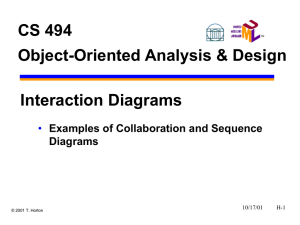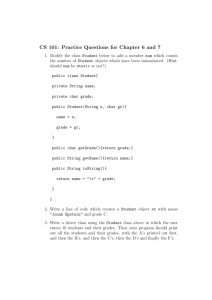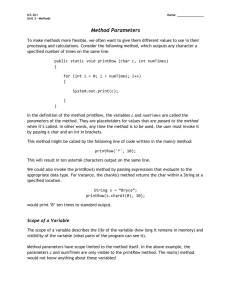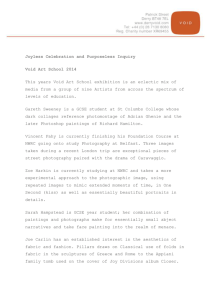uml-collab
advertisement
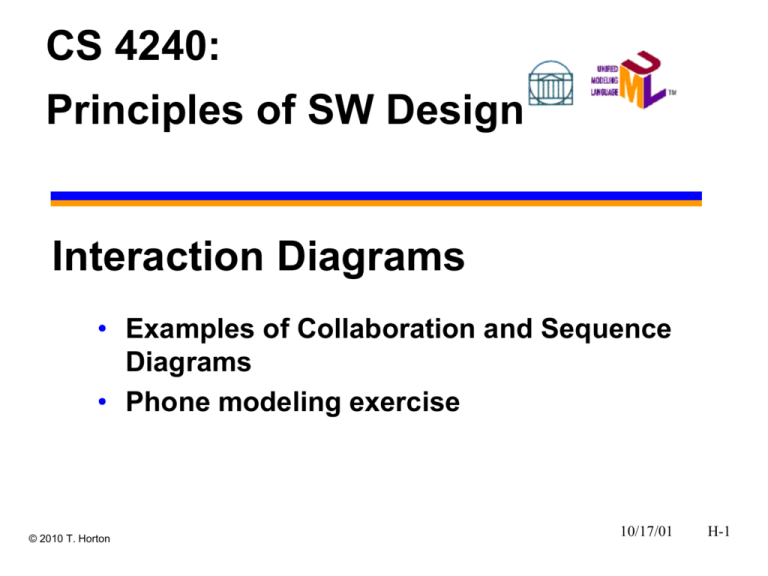
CS 4240: Principles of SW Design Interaction Diagrams • Examples of Collaboration and Sequence Diagrams • Phone modeling exercise © 2010 T. Horton 10/17/01 H-1 Dynamic Views in UML • Class diagrams are models of data types – What non-fundamental types are you using? How are they related? – Sometimes referred to as the static model • Running programs define objects of various types that interact – Control is passed between objects’ methods – Information is passed and returned • UML has two almost identical diagrams for this: – Collaboration diagram: object-centered – Sequence diagram: time-oriented • Important: Each diagram models a particular scenario – Often we just model important or interesting scenarios 10/17/01 H-2 Learn More! • UML Basics: The Sequence Diagram – http://www.ibm.com/developerworks/rational/li brary/3101.html – Good stuff on syntax details • Agile Modeling – http://www.agilemodeling.com/artifacts/sequen ceDiagram.htm – Good stuff on how these are used 10/17/01 H-3 Class Diagram with a Related Collaboration 10/17/01 H-4 Sequence Diagram: Ex. 1 10/17/01 5 Relationship Between Both Notations 10/17/01 H-6 Collaboration Diagram: Ex. 2 10/17/01 H-7 Sequence Diagram: Ex. 2 10/17/01 H-8 Iteration, Control, Return Values • Messages can be labeled with a condition: [hasStock] sellWidget() • Messages can be repeated: * msg() or *[k=1..2] msg() • Return values: – Maybe on dashed “return” arrow, or – On message call: n = getName() – Again, note returns not always explicitly drawn 10/17/01 H-9 Notes on Messages • Various types of messages supported – “Triangle” arrow head: • like procedure calls, nested flow of control. Caller waits for action to complete. – Asynchronous flow of control • Caller is not blocked, continues to do something. • UML 1 “Half” arrow head • UML 2: “Stick” arrow head (not triagle) – Dashed arrow: • Return from procedure call. May be omitted if it’s implicit at end of an activation box – Use stereotypes to define anything else. 10/17/01 H-10 Iterations, Constraints, Asynch. Messages 10/17/01 H-11 Use Cases and Sequence Diagrams • So far sequence diagrams model interactions between implementation-level objects • Also, can be used to model use cases – Actor(s) interacting with the System • Most useful if more than one Actor • Messages are used informally here – Example: ATM customer tries to overdraw • Also, sequence diagrams sometimes used in high-level design – model interactions between major subsystems 10/17/01 H-12 10/17/01 H-13 Phone Switch Example • Classes – Phone: a person’s telephone – Line: a “number” associated with a phone • Lines are busy, calls are made on lines, etc. – Connection: dynamically created, represents an active call between lines – Switch: a phone switch is a computer system that manages phones, lines and connections – Console: a terminal attached to the switch – Simulator: we’re writing a simulation! 10/17/01 H-14 Associations in Our Model • Switch manages other objects • More than one Phone may be “linked” to one line – Like for office secretary, boss • A Phone may have more than one Line – But, a Phone has only one Line “selected” at one time • Must choose a Line to call or answer – Also, when a Line is connected, not all Phones that can possibly use that Line may be participating in the call. • A Connection requires at least two Lines to exist 10/17/01 H-15 Conceptual Class Diagram controls Simulator Switch name : string 1 1 1 controls 0..* manages 0..*0..* Phone state : PhoneState name : string 0..* 1 1 1 manages 0..* manages 0..* Line 1 number : string state : LineState selected link edLines1..* 2..* Connection id : int state : ConnState duration : int 0..1 onConnection 1..* 1 10/17/01 H-16 Scenario • A normal call – – – – – – – – Phone1 chooses Line 1 and picks up Phone 1 dials number for Phone2 Phone 2 rings Phone 2 picks up Call completed and the two people talk Phone 2 hangs up Phone 1 is disconnected Phone 1 hangs up 10/17/01 H-17 Class Diagram with Operations Switch Simulator name : string controls processCmds(in : istream) 1 1 getPhone(name : string) : Phone 1 controls 1 getLine(number : string) : Line addLine(num : String) : void addPhone(p : Phone) : void linkLinePhone(name : string, num : int) : void newCall(l1 : Line, l2 : Line) : void completeConn(l : Line, c : Connection) : void destroyConn(c : Connection) : void 1 manages manages 0..* 0..* Phone 0..* state : PhoneState name : string selectLine(num : int) : void pickup() : void hangup() : void ring() : void dial(num : int) : void addLine(l : Line) : void 0..* Line state : LineState incomingCall(c : Connection) : void hungUp(p : Phone) : void linkedLines 1..* pickedUp(p : Phone) : void 0..* addPhone(p : Phone) : void 2..* onConnection 1..* manages 0..* Connection selected number : int 1 1 id : int state : ConnState duration : int disconnect(l : Line) : void addLine(l : Line) : void 0..1 1 10/17/01 H-18 Sequence Diagram for a Normal Phone Call s: Simulator p1: Phone s:Switch l1: Line c1: Connection l2: Line p2: Phone selectLine(n) pickup() dial(num) pickedUp(p1) l2 := getLine(num) newCall(l1, l2) <<create>> (l1) incomingCall(c1) ring() pickup() completeConn(l2,c1) pickedUp(p2) addLine(l2) hangup() destroyConn(c1) disconnect(l2) hungUp(p2) /* change state */ <<destroy>> hangup() hungup(p1) 10/17/01 H-19 Part of Same Diagram using Visual Paradigm
